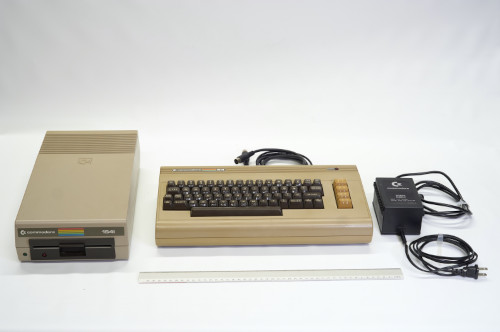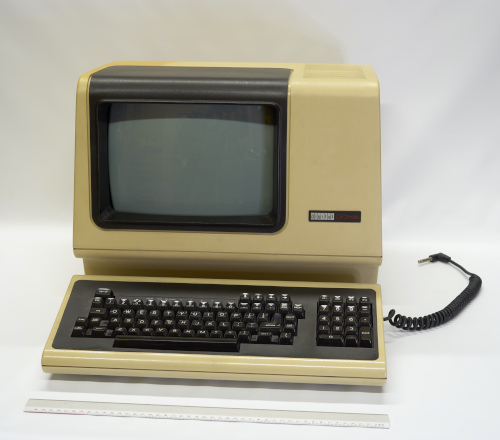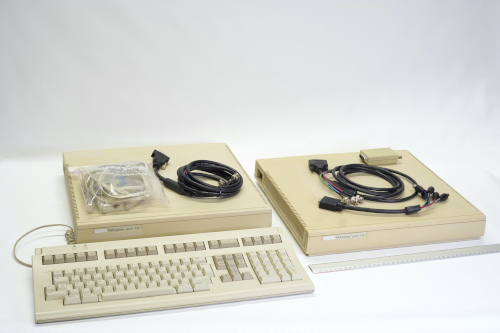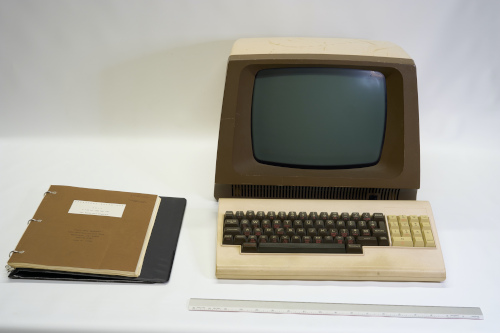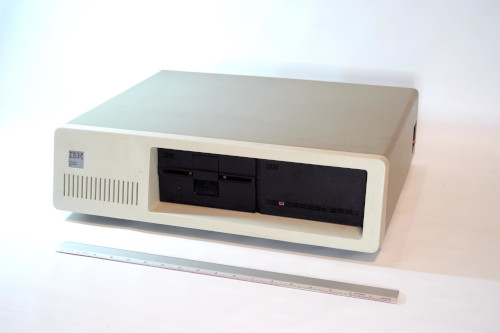
Donated by Robert Ferguson
The Commodore 64, also known as the C64, is an 8-bit home computer introduced in January 1982 by Commodore International. It has been listed in the Guinness World Records as the highest-selling single computer model of all time, with independent estimates placing the number sold between 12.5 and 17 million units. Volume production started in early 1982, marketing in August for US$595. Preceded by the VIC-20 and Commodore PET, the C64 took its name from its 64 kilobytes (65,536 bytes) of RAM. With support for multicolor sprites and a custom chip for waveform generation, the C64 could create superior visuals and audio compared to systems without such custom hardware.
View entry on Wikipedia
The Commodore PET is a line of personal computers produced starting in 1977 by Commodore International. A single all-in-one case combines a MOS Technology 6502 microprocessor, Commodore BASIC in read-only memory, keyboard, monochrome monitor, and, in early models, a cassette deck.
View entry on Wikipedia
DECmate was the name of a series of PDP-8-compatible computers produced by the Digital Equipment Corporation in the late 1970s and early 1980s. All of the models used an Intersil 6100 or Harris 6120 microprocessor which emulated the 12-bit DEC PDP-8 CPU. They were text-only and used the OS/78 or OS/278 operating systems, which were extensions of OS/8 for the PDP-8. Aimed at the word processing market, they typically ran the WPS-8 word-processing program. Later models optionally had Intel 8080 or Z80 microprocessors which allowed them to run CP/M. The range was a development of the VT78 which was introduced in July 1977.
View entry on Wikipedia
The PDP–11 is a series of 16-bit minicomputers sold by Digital Equipment Corporation (DEC) from 1970 into the late 1990s, one of a set of products in the Programmed Data Processor (PDP) series. In total, around 600,000 PDP-11s of all models were sold, making it one of DEC's most successful product lines. The PDP-11 is considered by some experts to be the most popular minicomputer.
View entry on Wikipedia
The VAXstation was a family of workstation computers developed and manufactured by Digital Equipment Corporation (DEC) using processors implementing the VAX instruction set architecture (ISA). VAX stood for Virtual Address EXtension.
The VAXstation 4000 VLC (Very Low Cost), aka VAXstation 4000 M30, was an entry-level workstation introduced on 30 October 1991. It was code named "PVAX2/VLC". It used the KA48 CPU module containing a 25 MHz (40 ns cycle time) SOC microprocessor. It had 8 to 24 MB of memory, using the MS40-BA SIMM, which was a low-height standard 72-pin 80 ns memory module with parity.
The VAXstation was a family of workstation computers developed and manufactured by Digital Equipment Corporation (DEC) using processors implementing the VAX instruction set architecture (ISA). VAX stood for Virtual Address EXtension.
The VAXstation 4000 VLC (Very Low Cost), aka VAXstation 4000 M30, was an entry-level workstation introduced on 30 October 1991. It was code named "PVAX2/VLC". It used the KA48 CPU module containing a 25 MHz (40 ns cycle time) SOC microprocessor. It had 8 to 24 MB of memory, using the MS40-BA SIMM, which was a low-height standard 72-pin 80 ns memory module with parity.
The IBM Personal Computer XT is the second computer in the IBM Personal Computer line, released on March 8, 1983. Except for the addition of a built-in hard drive and extra expansion slots, it is very similar to the original IBM PC model 5150 from 1981.
View entry on Wikipedia
The Osborne 1 is the first commercially successful portable computer, released on April 3, 1981 by Osborne Computer Corporation. It weighs 24.5 lb (11.1 kg), cost US$1,795, and runs the CP/M 2.2 operating system. It is powered from a wall socket, as it has no on-board battery, but it is still classed as a portable device since it can be hand-carried when the keyboard is closed.
View entry on Wikipedia
